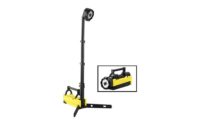
If you work in dark locations, the right flashlight is essential. But what options exist to guarantee maximum illumination and dependability in potentially dangerous environments?
DTE Energy, an electric and gas utility that includes Detroit Edison and MichCon, came up with the answer. About two years ago they made the transition from “throw-away” flashlights to high-quality professional lights that offer better features and durability. “A good flashlight is a valuable tool,” says Tom Grant, DTE’s shop engineer and tool committee chairman. “In the dead of night, our line men need good lighting to see what they are doing.”
Understand the ratings
Organizations such as Underwriters Laboratories Inc. (UL) and Factory Mutual Research (FM) test and approve high-performance flashlights. However, in order to use their ratings in your selection process, you must understand the environment where a flashlight will be used.
Any flashlight used in a hazardous environment or confined space should be properly tested to meet or exceed all applicable safety standards for those locations. Hazardous locations or potentially explosive atmospheres are areas where fire or explosion hazards may exist due to the presence of ignitable concentrations of flammable gases, liquids, vapors, dusts or ignitable fibers of flyings. These locations are classified according to the properties of flammable materials that may be present and the likelihood of flammable concentrations as defined by the National Electric Code.
Consider casings and lenses
Flashlight casings made from polymer engineering resin materials are virtually indestructible, shock resistant and non-conductible — important considerations in hazardous environments. Polymers don’t retain heat, making them suitable when fire or high temperatures may be present. Other flashlight materials include anodized, machined aluminum housing and ABS thermoplastic.
Many of today’s flashlight lenses are made of borosilicate, which offers good shock resistance. Others are made from polycarbonate, which is clear, tough, shatterproof and virtually unbreakable.
Advances in lighting technology
While known for durability and long life, LEDs (Light Emitting Diodes) have always lagged behind incandescent light sources in terms of power and brightness. A recent development, however, is “power” LEDs. These provide a two- to three-fold increase in brightness over previous generation Super High Flux LEDs and represent a major step forward.
Power LEDs have the light output to match traditional light sources, enabling manufacturers to replace incandescent, halogen and fluorescent bulbs with LEDs that are not only longer lasting, but able to produce more than 100 lumens of light for every watt of battery power consumed, making them much more efficient than incandescent lights.
Rechargeable vs. standard battery-powered lights
Understanding the latest innovations in battery technology will aid in the selection of flashlight models. Developments such as the lithium ion battery have reached new benchmarks in rechargeability, leading to flashlights’ reduced size and weight. Rechargeables tend to burn brighter than those that use disposable batteries, which can be a safety asset.
Another benefit of rechargeable lights is savings. They may be able to be recharged 1,000 times, providing an average savings of at least $300 in battery costs over a four-year period. In addition, rechargeable battery lights offer environmental benefits. At Detroit Edison, for example, rechargeables are among the options because of their ability to reduce the volume of disposable batteries.
Flashlights with standard disposable batteries are still widely used. Understanding how frequently a flashlight will be used is key in selecting either rechargeable or disposable battery flashlights. With frequent usage, disposable standard batteries, such as alkaline, will last for approximately two weeks. Disposable standard batteries have excellent storage life and can be depended upon to work in an emergency. They generally offer longer runtimes for a given bulb power, another safety consideration, and are typically lower in initial purchase price and easier to keep spares on hand.
Brightness
Flashlights come with several kinds of bulbs, with the biggest differences being brightness, longevity, durability of the bulb and cost.
- Incandescent (filament-based): Xenon and halogen lamps provide high output for their size and a white, natural light. They are easily focused, and with the most power and highest performance, are the best choice for long distances. They require periodic replacement and can shatter and fail on extreme impact.
- LED (Light Emitting Diodes): These are made from solid-state construction, offer up to 100,000 hours of life and do not require periodic replacement. With soft focus and short range, they are good for close work. Although providing somewhat less “throw” than incandescents, they can deliver extremely long runtimes at low levels. They are also virtually unbreakable, an important safety consideration.
- Super High Flux LED: This option delivers the reliability and durability of an LED with the performance of an incandescent.
- Combination LED/ Incandescents: LED/Xenon combination lights combine the long running times and durability of LEDs with the brightness of an incandescent. Operation can be switched according to the specific task at hand, an advantage for workers who encounter a variety of conditions on the job.
In addition to hand-held flashlights, there are numerous other models to consider. In a confined space, for example, professional-grade headlamps offer the user hands-free operation to maximize worker safety.
Some models of traditional penlights have been redesigned to include a bendable, extendable cable that enables the user to see in even the tightest spots, while others feature a handy laser pointer for precisely targeting the source of a problem for a co-worker. High Intensity Discharge (HID) Xenon lights and lanterns offer ultra-bright portable light, useful for illuminating roadways or accident scenes.
Bottom line: Choosing the right light for a specific task can make the difference between a dangerous or safe environment.
